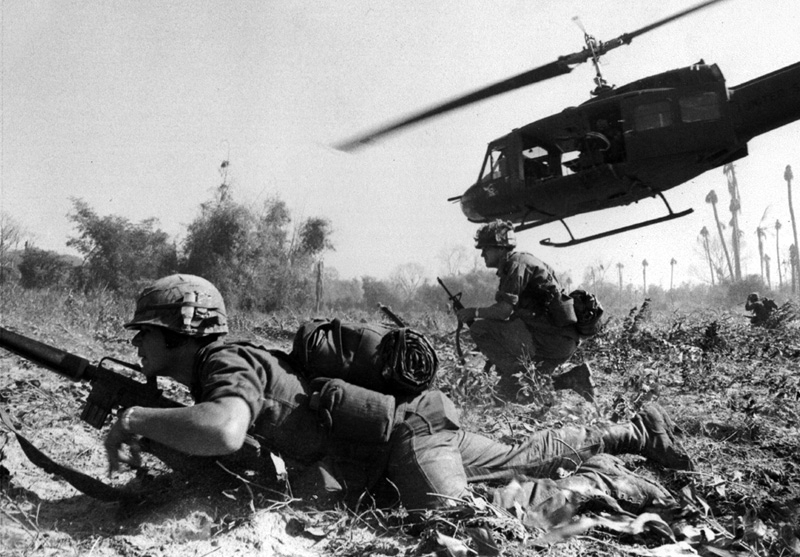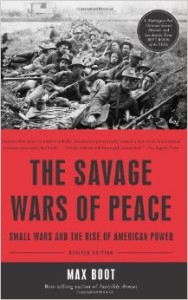The Savage Wars of Peace
The Savage Wars of Peace provides insights into why the United States conducted these operations, how they were executed, and whether they were successful or not. The rationale for repeated involvement in Latin America, the conduct of soldiers, and the legacy of these conflicts are all discussed in detail. It is informative no matter one’s opinion. Perhaps the book will not change your opinion on U.S. warfighting, but it will certainly give you a greater appreciation of how war actually unfolds.

Bruce Crandall's UH-1D. Photograph by United States Army ! Wikicommons

At some point we have all discussed war. These discussions generally start along the lines of its merits and drawbacks, why countries engage in war, and when we will be swept up in the next one. Those debating, if doing so for any length of time, bring up past wars and conflicts to bolster arguments, and make the case for or against the use of force in particular scenarios. If the discussion is on contemporary conflicts, as it most often is, it will probably not be just about war, but American war.
If you’re here, you’ve undoubtedly participated in these debates. Likely ad nauseam. If you foresee yourself stumbling into such discussions in the future, Max Boot’s The Savage Wars of Peace: Small Wars and the Rise of American Power should be at the top of your reading list.
The U.S. Civil War. World War I. World War II. The Korean War. The Vietnam War. These are the wars that shape Americans’ perception of human conflict; the wars where America stakes all of her “blood and treasure to achieve the relatively quick and unconditional surrender of the enemy.” The “American way of war.”
Max Boot, a leading military historian and Senior CFR fellow, posits that this is only one way of war, and one that is increasingly rare. Big wars are an exception in a score of small, localized conflicts. Soldiers, more often than not, find themselves performing counter-insurgency, establishing law and order, and building infrastructure—not facing enemy combatants in the battlefield—all while acting under limited authorities.
Low-intensity conflicts. No declaration of war. Murky objectives. These are the wars that define the American military experience—however unaware of it we civilians are. A quick look at the book’s table of contents reveals the largely unknown history of small wars: the Barbary Wars, China, Samoa, China again, the Philippines, Cuba, Panama, Mexico. And that’s only half the list. Even if we know many of these conflicts, do we understand what happened, much less why policymakers decided to act in the first place?
If history can serve as a guide for the future, then this book is as close as it gets to a road map for the wars to come. Published in 2002, Boot’s observations on the different policies required for small wars are prescient considering the trajectories of the Iraq and Afghanistan Wars. The eviction of Saddam Hussein and the Taliban was swift; erecting stable governments that could represent U.S. interests proved elusive. Yemen will be another test of whether a foreign power can establish a stable government and drain insurgent support.
The Savage Wars of Peace provides insights into why the United States conducted these operations, how they were executed, and whether they were successful or not. The rationale for repeated involvement in Latin America, the conduct of soldiers, and the legacy of these conflicts are all discussed in detail. It is informative no matter one’s opinion. Perhaps the book will not change your opinion on U.S. warfighting, but it will certainly give you a greater appreciation of how war actually unfolds.
Boot doesn’t just provide an overview of these wars; he proposes the Vietnam War should be classified as a small war. As the term “refers more to a style of warfare—clashes with guerrilla or irregular forces,” not the number of combatants, Vietnam is Boot’s best example of the price of employing big war tactics in small war scenarios—where traditional weapons play only a marginal role and massive decisive battles are an exception. Rather, rebellious or insurgent groups attempt to sap the invader’s morale by striking at soft targets and melding into the civilian population. The policy options generally fall between quasi-total subjugation of the population or draining public support for the insurgency. And time is not on the invading force’s side in either scenario.
The book’s case for Vietnam is compelling. The massive amount of ordnance dropped on Vietnam and Cambodia did not result in victory. Advanced weaponry and logistics tilted the scale of combat deaths in favor of the United States, but did not result in the desired policy objectives. The only big battle in Vietnam, the Tet Offensive, was actually a tactical disaster for the Viet Cong forces; it shattered their ability to mount any such type of attack again. But the Viet Cong tactics of attrition, in combination with misaligned U.S. policies, ensured the local population was not going to switch sides. It was just a matter of time before the U.S. withdrew. Boot believes policymakers would have been well served to consult the U.S. military’s experience with small warfare before entering Vietnam. In fact, they wouldn’t have had to look far—the U.S. Marine Corps had produced a manual capturing the lessons up to 1940. But Vietnam wasn’t, and for many still isn’t, considered a small war.
Boot ends with some interesting questions. We know how high the cost can be for misguided intervention—Vietnam to name one—but what about the cost of non-intervention? What would the world look like if the Bolsheviks had been pushed off-course in 1919, as could have been the case if the United States had fully intervened? Also, should the U.S. commit to wars that are partly driven by humanitarianism, such as the Spanish-American or Kosovo War, or stick to the national interest, like the rest of the world? Rwanda comes to mind, but then where does one draw the line? Genocide? Chemical weapons? These questions are no less relevant today than they were after the first expeditions to the Maghreb in 1801.
As far as military histories go, The Savage Wars of Peace is neither esoteric nor tedious. Rather, it flows between the portraits of the Marine Corps’ most famous soldiers, the decision-making process in the White House, and the lives of the local populations under U.S. occupation in a style that captures the reader’s attention. If you want to know more about why the United States fights, where those fights have taken place, and what future fights may resemble, read this book. Next time the euphemism “low-intensity conflict” appears in the news, keep in mind the lessons of The Savage Wars of Peace.
 The Savage Wars of Peace: Small Wars and the Rise of American Power
The Savage Wars of Peace: Small Wars and the Rise of American Power
Max Boot
Basic Books, 2002
M.A. Candidate, Politics







I believe that is my grandpa squatting by the plan! We seen this years ago and our hearts hit the floor.. It just has to be him!
Sergeant Edward Hurcombe Sr Air Borne Ranger